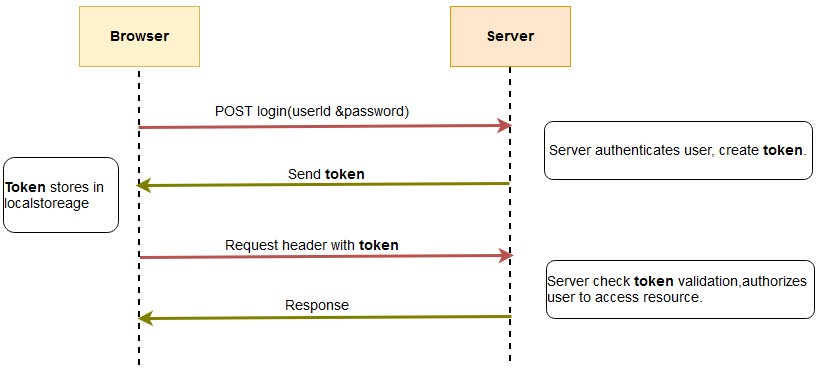在網站的世界裡認證授是我們一定會遇到的問題,認證(Authentication)你是否為合法使用者,授權(Authorization)你可以訪問那些頁面。 前面提到過cookie-based authentication的方式,使用者輸入帳號密碼驗證無誤後,在後端產生session id儲存在Server memory並設置在cookie中返回給user瀏覽器,使用者接下來的請求cookie都會自動帶上cookie訪問server,server端只需要確認傳的sessionId有效就可以通過認證。
這樣做會有一些問題,其一當使用者太多會耗太多Server上資源,再者綁定在單一的domain上,想要實作多個domain指登入一次就需要考慮session如何共享的問題,一般可以將sessionId存在redis db讓多個AP Server存取來解決這個問題。今日就來看看JWT如何來做認證授權。
確認使用者登入資訊後產生token回傳給Client,Client將token存放在瀏覽器的localStoreage或sessionStorage中,下次請求的時候將cookie設置在hearder中,目前主流技術使用JWT來實現。
JSON Web Token(JWT),顧名思義這個token會用JSON物件進行封裝,JWT由三個部分組成:header、payload、signature,header會放置加密算法的訊息,payload會放置一些使用者的資訊,signature的作用是驗證資訊未被竄改過,即資訊的完整性(integrity)。整個JWT生成大致就像下面的流程:
知道上面的原理就可以自己來試著寫寫看
@WebServlet("/TokenServlet")
public class TokenServlet extends HttpServlet {
@Override
protected void doGet(HttpServletRequest req, HttpServletResponse resp) throws ServletException, IOException {
String header = "{\"alg\":\"HS256\"}";
String claims = "{\"sub\":\"Joe\"}";
String encodedHeader = Base64.getUrlEncoder().encodeToString(header.getBytes("UTF-8"));
String encodedClaims = Base64.getUrlEncoder().encodeToString( claims.getBytes("UTF-8") );
String concatenated = encodedHeader + '.' + encodedClaims;
String key = "signature_key";
try {
SecretKey secretKey = getMySecretKey(key);
byte[] signature = hmacSha256( concatenated, secretKey );
System.out.println(signature.toString());
String compact = concatenated + '.' + Base64.getUrlEncoder().encodeToString( signature );
System.out.println("encrypt:"+ compact );
System.out.println("========generate========");
String[] split = compact.split("\\.");
System.out.println(split[0]);
System.out.println(split.length);
System.out.println("header:"+new String(Base64.getUrlDecoder().decode(split[0])));
System.out.println("payload:"+new String(Base64.getUrlDecoder().decode(split[1])));
System.out.println("signature:"+Base64.getUrlDecoder().decode(split[2]));
System.out.println("=======validate=========");
String headerAndClaims = split[0].toString()+"."+split[1].toString();
System.out.println(headerAndClaims);
byte[] hash = hmacSha256( headerAndClaims, secretKey );
String signatureValidate = Base64.getUrlEncoder().encodeToString(hash);
//完整性驗證
System.out.println(split[2]);
System.out.println(signatureValidate.equals(split[2]));
} catch (NoSuchAlgorithmException e) {
throw new RuntimeException(e);
} catch (InvalidKeyException e) {
throw new RuntimeException(e);
}
}
private byte[] hmacSha256(String concatenated, SecretKey secretKey) throws InvalidKeyException, NoSuchAlgorithmException {
Mac mac = Mac.getInstance("HmacSHA256");
mac.init((SecretKeySpec)secretKey);
return mac.doFinal( concatenated.getBytes());
}
private SecretKey getMySecretKey(String key) throws UnsupportedEncodingException {
SecretKeySpec secretKeySpec = new SecretKeySpec(key.getBytes("UTF-8"), "SHA-256");
return secretKeySpec;
}
}
當然你可以不用那麼累全部都自己來,但是走過土法煉鋼的方式才是能清楚知道原理,也才能更了解其他現成套件的用法,JJWT就是滿常見的Java JWT開源套件
import jjwt package
<dependencies>
<dependency>
<groupId>io.jsonwebtoken</groupId>
<artifactId>jjwt-api</artifactId>
<version>0.12.6</version>
</dependency>
<dependency>
<groupId>io.jsonwebtoken</groupId>
<artifactId>jjwt-impl</artifactId>
<version>0.12.6</version>
<scope>runtime</scope>
</dependency>
<dependency>
<groupId>io.jsonwebtoken</groupId>
<artifactId>jjwt-jackson</artifactId> <!-- or jjwt-gson if Gson is preferred -->
<version>0.12.6</version>
<scope>runtime</scope>
</dependency>
</dependencies>
create JWTokenServlet
@WebServlet("/JWTokenServlet")
public class JWTokenServlet extends HttpServlet {
// case01 自定義的 Secret Key 字符串,請確保密鑰長度足夠不然會抱錯
private static final String SECRET_KEY = "SecretKey12345aaaaaaaaaaaaaaaaaaaaaaaaaaaaaa"; //
// case01 將自定義的字符串密鑰轉換為 SecretKey 對象
private static final Key key = new SecretKeySpec(
SECRET_KEY.getBytes(StandardCharsets.UTF_8),
SignatureAlgorithm.HS256.getJcaName());
//case02 由api幫忙產key這裡使用 HMAC SHA256 算法
//private static final SecretKey key = Keys.secretKeyFor(SignatureAlgorithm.HS256);
// Token 有效期設置
private static final long EXPIRATION_TIME = 1000 * 60 * 30; // 30 minutes
@Override
protected void doGet(HttpServletRequest req, HttpServletResponse resp) throws ServletException, IOException {
String token =Jwts.builder()
.setSubject("joe") // Token 持有者(用戶)
.setIssuedAt(new Date()) // Token 發行時間
//.setExpiration(new Date(System.currentTimeMillis() - EXPIRATION_TIME)) // case03設置過期時間
.setExpiration(new Date(System.currentTimeMillis() + EXPIRATION_TIME))
.signWith(key) // 使用自定義 Secret Key 簽名
.compact();
System.out.println(token);
String token2 = "eyJhbGciOiJIUzI1NiJ9.eyJzdWIiOiJqb2UifQ.BSYS75uTwiZo61aPYYbTsatv09PanHZvpgrFChkFty1B";
try {
Claims claims = Jwts.parser()
.setSigningKey(key) // 使用相同的 Secret Key 來驗證 Token
.build()
.parseSignedClaims(token)//如果時間超過或是完整性沒過都會拋exception
.getBody();
boolean isValid = claims.getExpiration().after(new Date());
System.out.println(isValid);
System.out.println(claims);
}catch(ExpiredJwtException e){
System.out.println("token expired");
e.printStackTrace();
}catch(SignatureException e){
System.out.println("signature error");
e.printStackTrace();
}
}
}
正常訪問就是使用自訂義的Secret Key
將case01的部分註解起來,並把case02註解打開,測試一下
將case03的註解打開並把下一行註解,測試一下ExpiredJwtException
將case4的token改成token2,測試一下SignatureException
